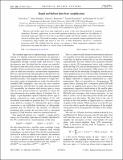Files in this item
Rapid and Robust Spin State Amplification
Item metadata
| dc.contributor.author | Close, Tom | |
| dc.contributor.author | Fadugba, Femi | |
| dc.contributor.author | Benjamin, Simon C. | |
| dc.contributor.author | Fitzsimons, Joseph | |
| dc.contributor.author | Lovett, Brendon W. | |
| dc.date.accessioned | 2014-08-21T09:31:02Z | |
| dc.date.available | 2014-08-21T09:31:02Z | |
| dc.date.issued | 2011-04-22 | |
| dc.identifier | 79639158 | |
| dc.identifier | 06ee166a-5b44-4bc6-8157-cf12fe536b78 | |
| dc.identifier | 000290097500016 | |
| dc.identifier | 79960620415 | |
| dc.identifier.citation | Close , T , Fadugba , F , Benjamin , S C , Fitzsimons , J & Lovett , B W 2011 , ' Rapid and Robust Spin State Amplification ' , Physical Review Letters , vol. 106 , no. 16 , 167204 . https://doi.org/10.1103/PhysRevLett.106.167204 | en |
| dc.identifier.issn | 0031-9007 | |
| dc.identifier.other | ORCID: /0000-0001-5142-9585/work/47136540 | |
| dc.identifier.uri | https://hdl.handle.net/10023/5204 | |
| dc.description | This work was supported by the EPSRC, the National Research Foundation and Ministry of Education, Singapore, and the Royal Society. | en |
| dc.description.abstract | Electron and nuclear spins have been employed in many of the early demonstrations of quantum technology. However, applications in real world quantum technology are limited by the difficulty of measuring single spins. Here we show that it is possible to rapidly and robustly amplify a spin state using a lattice of ancillary spins. The model we employ corresponds to an extremely simple experimental system: a homogenous Ising-coupled spin lattice in one, two, or three dimensions, driven by a continuous microwave field. We establish that the process can operate at finite temperature (imperfect initial polarization) and under the effects of various forms of decoherence. | |
| dc.format.extent | 4 | |
| dc.format.extent | 206585 | |
| dc.language.iso | eng | |
| dc.relation.ispartof | Physical Review Letters | en |
| dc.subject | Single-shot readout | en |
| dc.subject | Electron-spin | en |
| dc.subject | Quantum-dot | en |
| dc.subject | QC Physics | en |
| dc.subject.lcc | QC | en |
| dc.title | Rapid and Robust Spin State Amplification | en |
| dc.type | Journal article | en |
| dc.contributor.institution | University of St Andrews. School of Physics and Astronomy | en |
| dc.contributor.institution | University of St Andrews. Condensed Matter Physics | en |
| dc.identifier.doi | https://doi.org/10.1103/PhysRevLett.106.167204 | |
| dc.description.status | Peer reviewed | en |
This item appears in the following Collection(s)
Items in the St Andrews Research Repository are protected by copyright, with all rights reserved, unless otherwise indicated.

